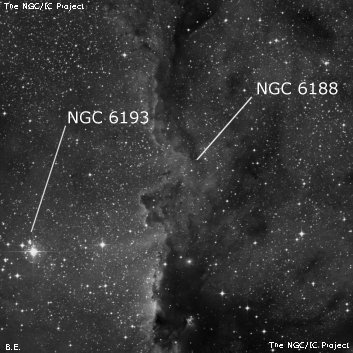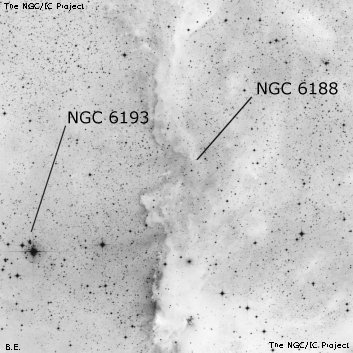NGC/IC Project Restoration Effort
(This is a very very beta version)
NGC6188


Basic Information
Location and Magnitude
Right Ascension: 16:40:5.0
Declination: -48:39:42
Constellation: ARA
Visual Magnitude:
Historic Information
Discoverer: Herschel J.
Year of discovery: 1836
Discovery aperture: 18.3
Observational
Summary description: ! F, vL, viE, B * inv
Sub-type: EN+RN
Corwin's Notes
=====
NGC 6188 is a large diffuse nebula involving the cluster NGC 6193. The
central section of the bright nebulosity surrounds an area of absorption
clouds with a sprinkling of stars in the foreground. The entire extent of the
complex is about a degree and a half north to south, and about a degree east
to west. NGC 6193 is in the eastern edge.
JH describes the nebula in much the same way: "The brightest part of a vL, F,
diffused, branching nebula, which involves in its nf part the * B5789
[HD 150135/6], and extends into the cl [Dunlop] 413, which it in part
surrounds." He gives only an approximate position for the nebula, marking
both coordinates with plus-minus signs. I see the brightest strands of
nebulosity on the red DSS2 images about 15 arcminutes northeast of his
position, and Andris Lauberts makes the center about 10 arcminutes further on
to the north. Any of these positions will serve to identify the whole nebular
complex, but I have chosen my own to represent the NGC object as JH
specifically calls out the brightest part of the object.
Steve's Notes
=====
NGC 6188
18" (7/10/02 - Magellan Observatory, Australia): With the 27mm Panoptic at 76x and UHC filter, this is an amazing region of bright and dark nebulosity involving open cluster NGC 6193 and extending throughout the entire 51' field in a N-S orientation. The bright nebulosity is split into two large sections by a dark lane that runs N-S. The eastern portion is the most prominent and includes the scattered cluster NGC 6193 and its three brighter stars (5.6/6.8/7). On the southern end of this section the nebulosity tapers down towards the SW corner, 15' to 20' from the core of the cluster. The western rim of the nebula is sharply defined with a locally brighter, crisp edge delineated by the dark river that meanders N-S throughout the field. The eastern and northern ends fade into the rich Milky Way background field.
A nearly perfect ellipse of moderately bright stars is just SW of the main body of the cluster and beyond the edge of nebulosity into the rift. The center of this ring is within the highest contrast portion of the dark rift, although the eastern side of the ring intersects the bright edge. This 15'x10' loop of stars spans the two sections of nebulosity.
The western portion of the nebulosity extends mostly NW of the elliptical ring and is clearly fainter. The highest contrast is along its eastern rim and runs N-S, roughly parallel to its brighter counterpart on the east side of the rift. The nebulosity fades towards the north and west with no well-defined edge but again is quite extensive. The catalogued dimensions of 20'x12' are too small and covers only the brightest portion of this much more extension HII/dark nebula complex.
8" (7/13/91 - Southern Baja): very large faint nebulosity which envelops open cluster NGC 6193, about 20' diameter. Extends roughly E-W through the cluster but also a very long brighter streak oriented N-S extends mainly to the south on the west side of cluster. This streak is well defined with an abrupt edge but there is no contrast gain with a UHC filter.
8" (7/16/82): faint, moderately large, low surface brightness glow on the west side of open cluster NGC 6193. This object is very low on the horizon from Northern California (less than 3 degrees max elevation).



